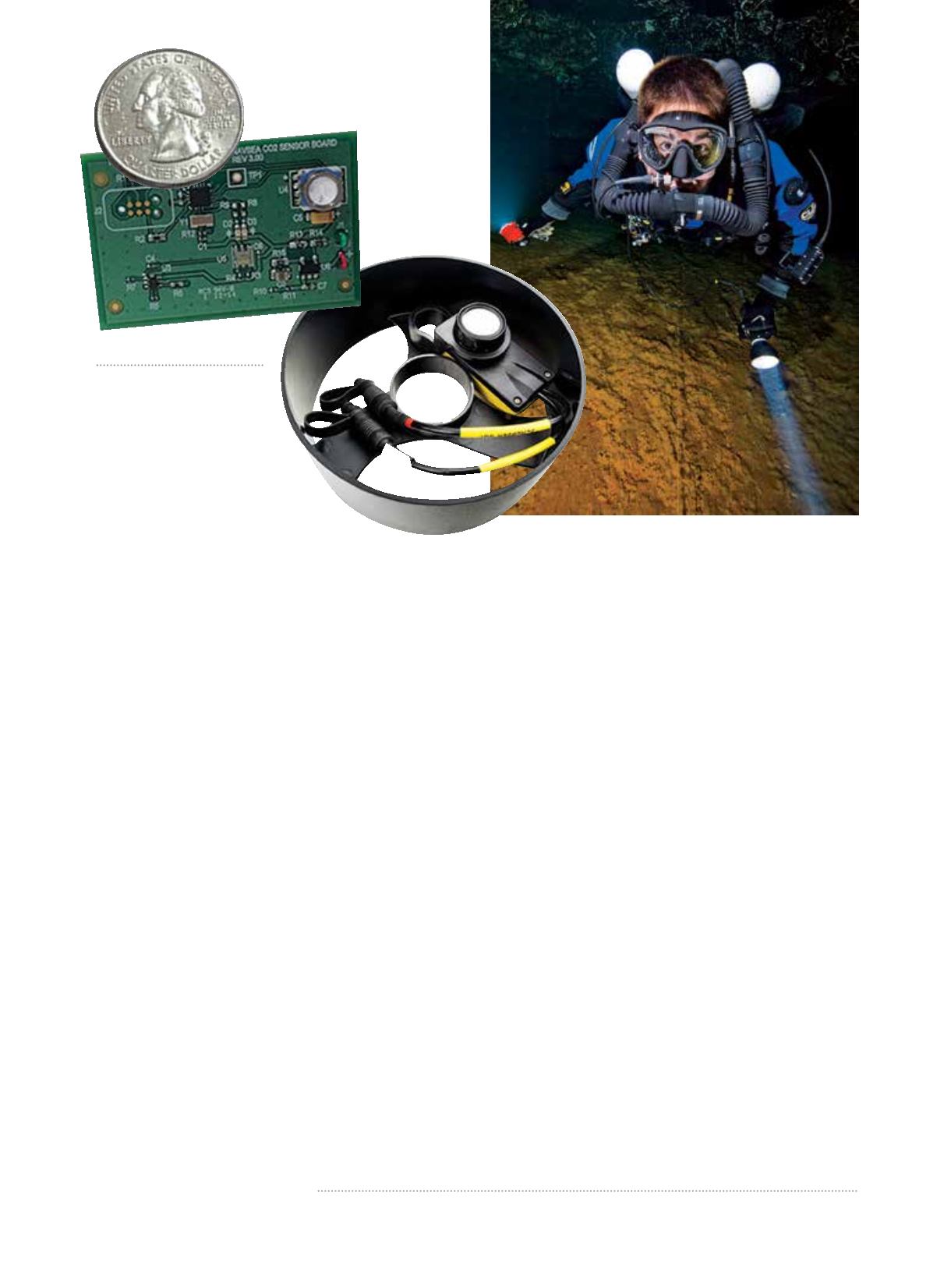

THE SENSEI OF SENSORS
The Navy wants to improve safety by
equipping rebreathers with both a scrubber gauge
and one or more CO
2
sensors. Interestingly,
sport rebreathers were first to incorporate the
combined solution.
In 2008, rebreather pioneer Kevin Gurr of VR
Technology Ltd. launched the Sentinel, which included
a thermal array licensed from NEDU along with the
then-groundbreaking low-power NDIR sensor from
Gas Sensing Solutions (GSS). He later incorporated
these into the Explorer, which was sold to Hollis Inc.
AP Diving introduced its own version of the GSS
sensor for its rebreathers in 2014. rEvo Rebreathers has
also licensed NEDU’s array.
The GSS sensor projects an infrared LED light
through a sample of gas exiting the scrubber and
calculates CO
2
levels based on the amount of light
absorbed. Unfortunately water vapor also absorbs
infrared light and thus reads as CO
2
, so a barrier must
be used to keep the sensor dry. This is no small task in
a 100 percent humid environment, but it can usually be
achieved with replaceable filters.
The software also requires extensive calibration data
because light absorption changes with pressure in a
noncomputable way. Because of its placement, the
sensor is unable to detect a mushroom value failure or
arterial CO
2
buildup.
Although the sensors have proved finicky and in
some cases have had to be replaced, most users are
supportive. “The current sensor is a fantastic addition
to rebreather safety,” an APD diver told me. “It just
seems like it is still in development.”
The game changer may be a new sensor technology
developed by Polestar Technologies Inc. that NEDU
is currently testing for use with oxygen rebreathers.
At its core is a quarter-sized disc of polymer film
that changes from blue to yellow in a reversible and
predictable way when exposed to CO
2.
Notably,
moisture does not affect its operation.
A tiny white LED light illuminates the disc from a
sealed pot below that houses the electronics. A digital
meter reads the color, which is converted to the CO
2
level.
The heads-up display gives a green light for good and
flashes red when CO
2
levels reach a predetermined limit.
It can easily be integrated into a mixed-gas rebreather.
In the future the device could be adapted to fit
inside a rebreather mouthpiece and measure the end
tidal CO
2
in the diver’s exhalation — the holy grail of
CO
2
sensing — to estimate arterial CO
2
levels. Future
rebreathers may sport multiple sensors.
Although the technology exists, only six of the more
than 20 rebreather manufacturers offer some form of
CO
2
protection, and only two offer both an array and
sensor. Many don’t see the need. As one manufacturer
told me, “Divers just need to learn to pack their
scrubber properly.”
Given that rebreather fatality rates have been
estimated to be five to 10 times higher than open-
circuit rates, perhaps the question is better put to the
divers themselves: “Do you want to know what you’re
breathing, or not?”
AD
ALERTDIVER.COM|
111
From far left:
Hollis Explorer
CO
2
sensor with humidity
filter; Polestar Technology’s
sensor circuit board; AP
Diving CO
2
sensor positioned
in lid; a rebreather diver
contemplates his gas mix
REFERENCE:
1
Deng C, Pollock NW, Gant N, Hannam JA, Dooley A, Mesley P, Mitchell SJ. The five-minute prebreathe in evaluating carbon
dioxide absorption in a closed-circuit rebreather: a randomized single-blind study. Diving Hyperb Med. 2015; 45(1):16-24.
BECKY KAGAN SCHOTT, LIQUID PRODUCTIONS
















